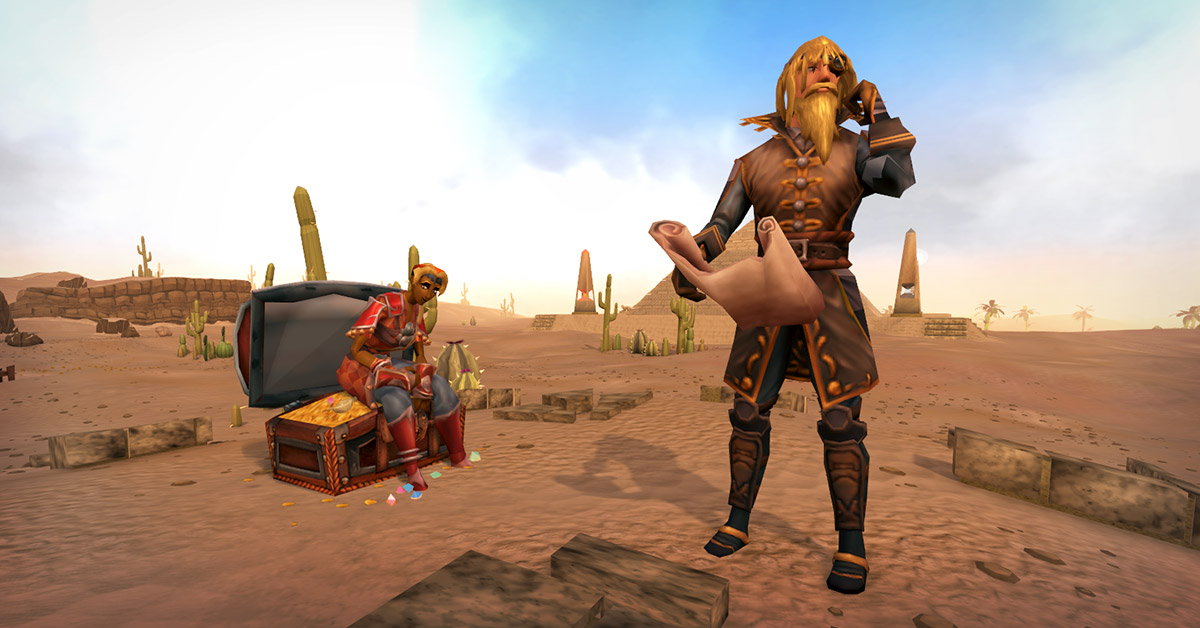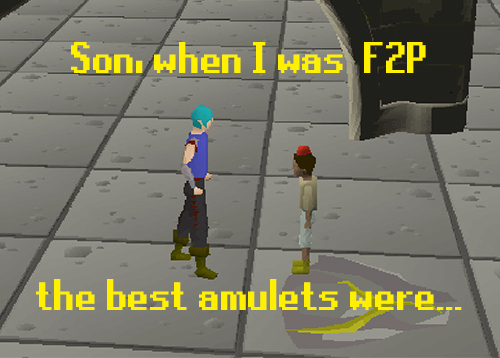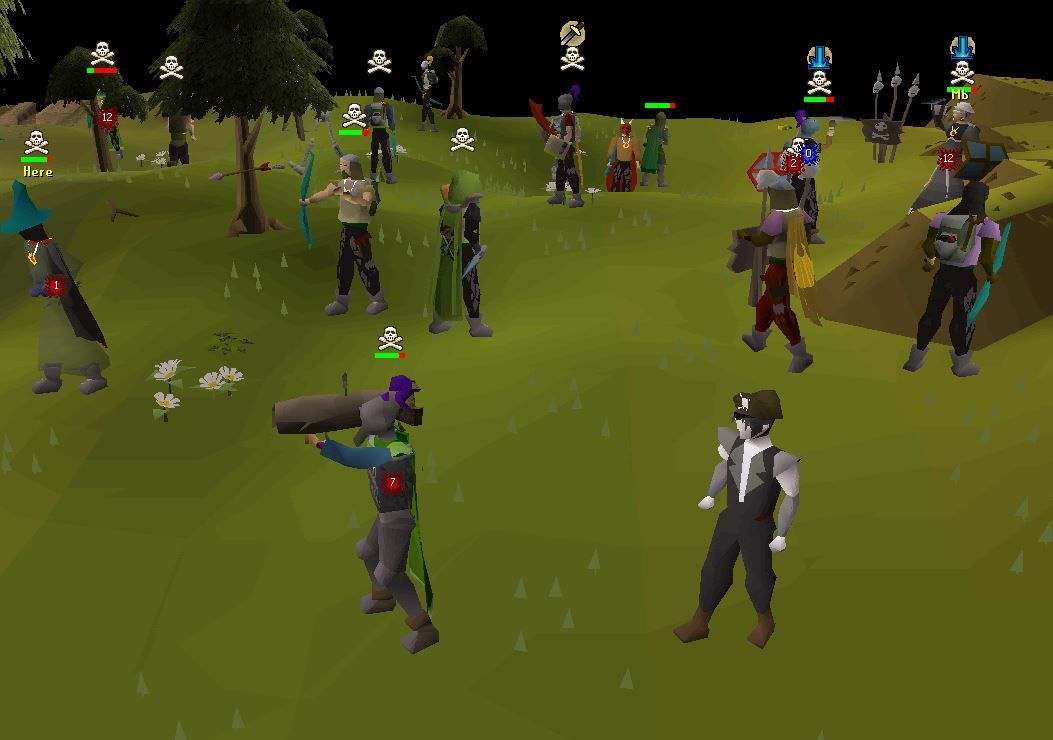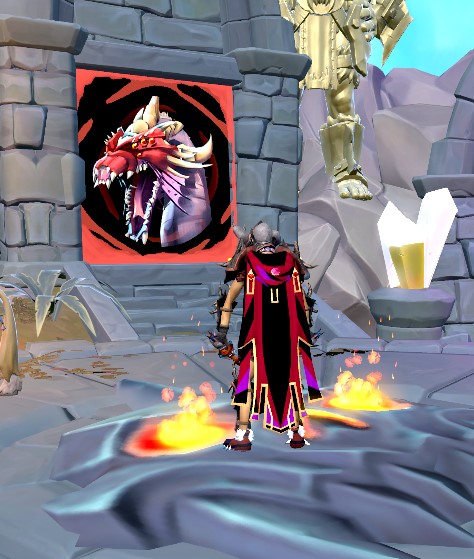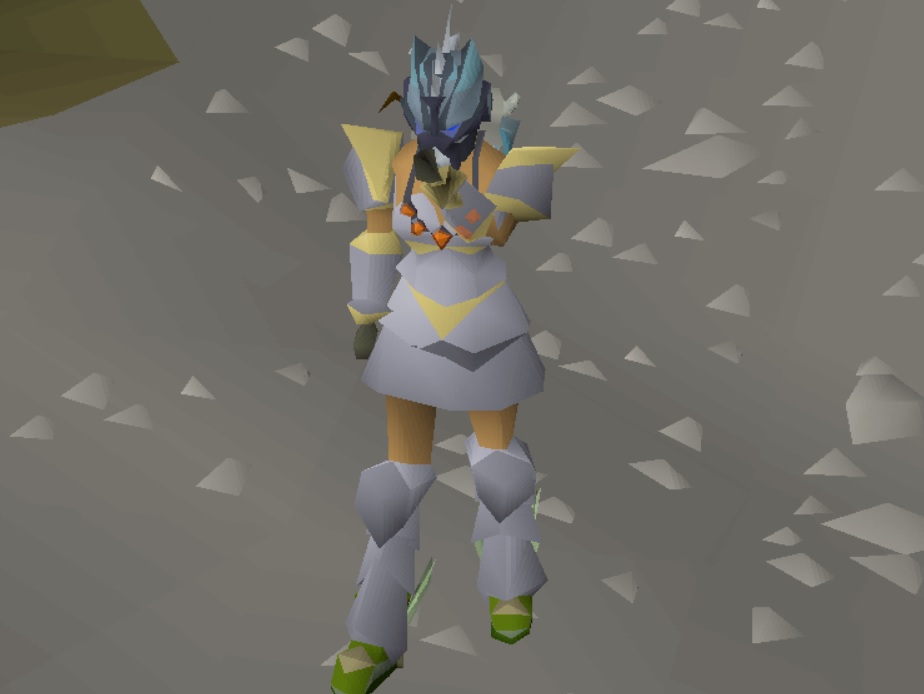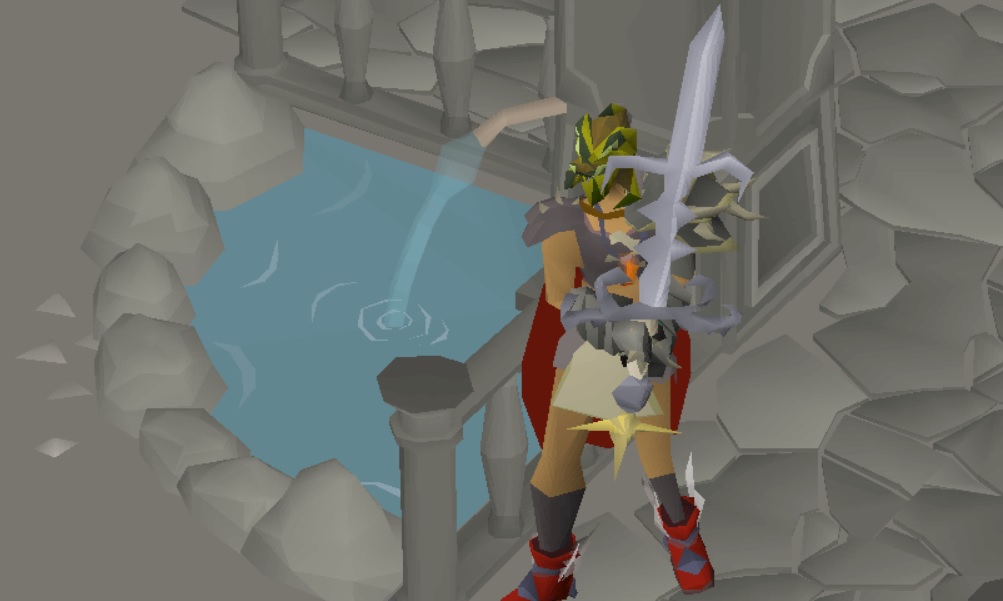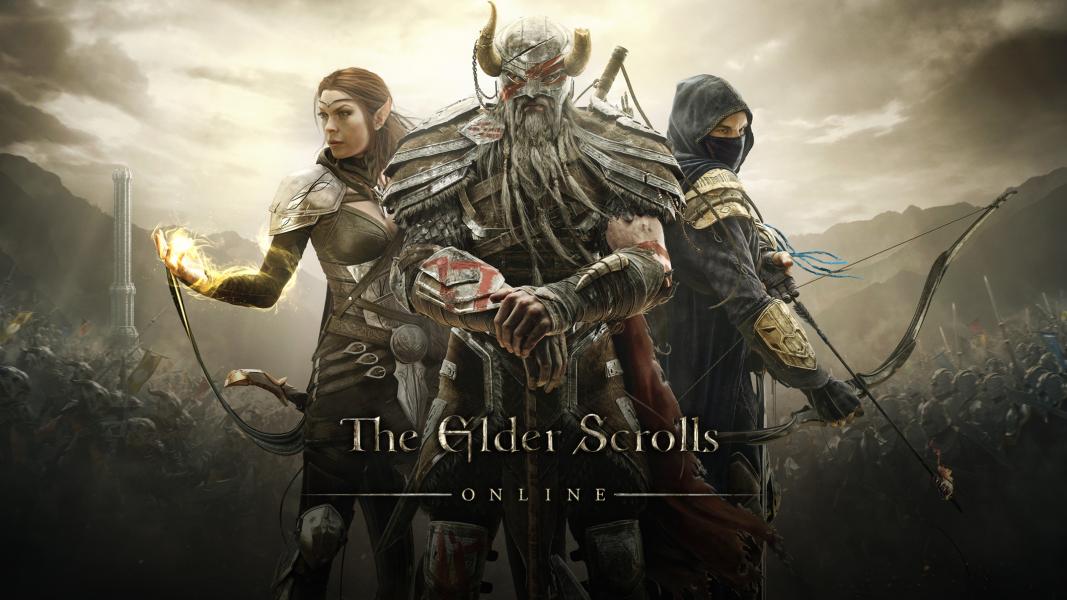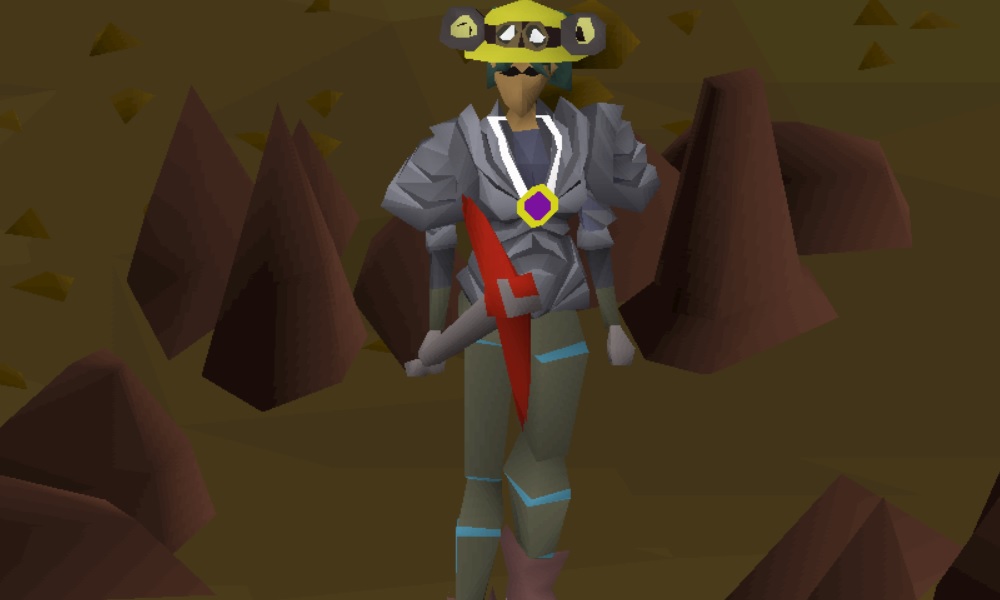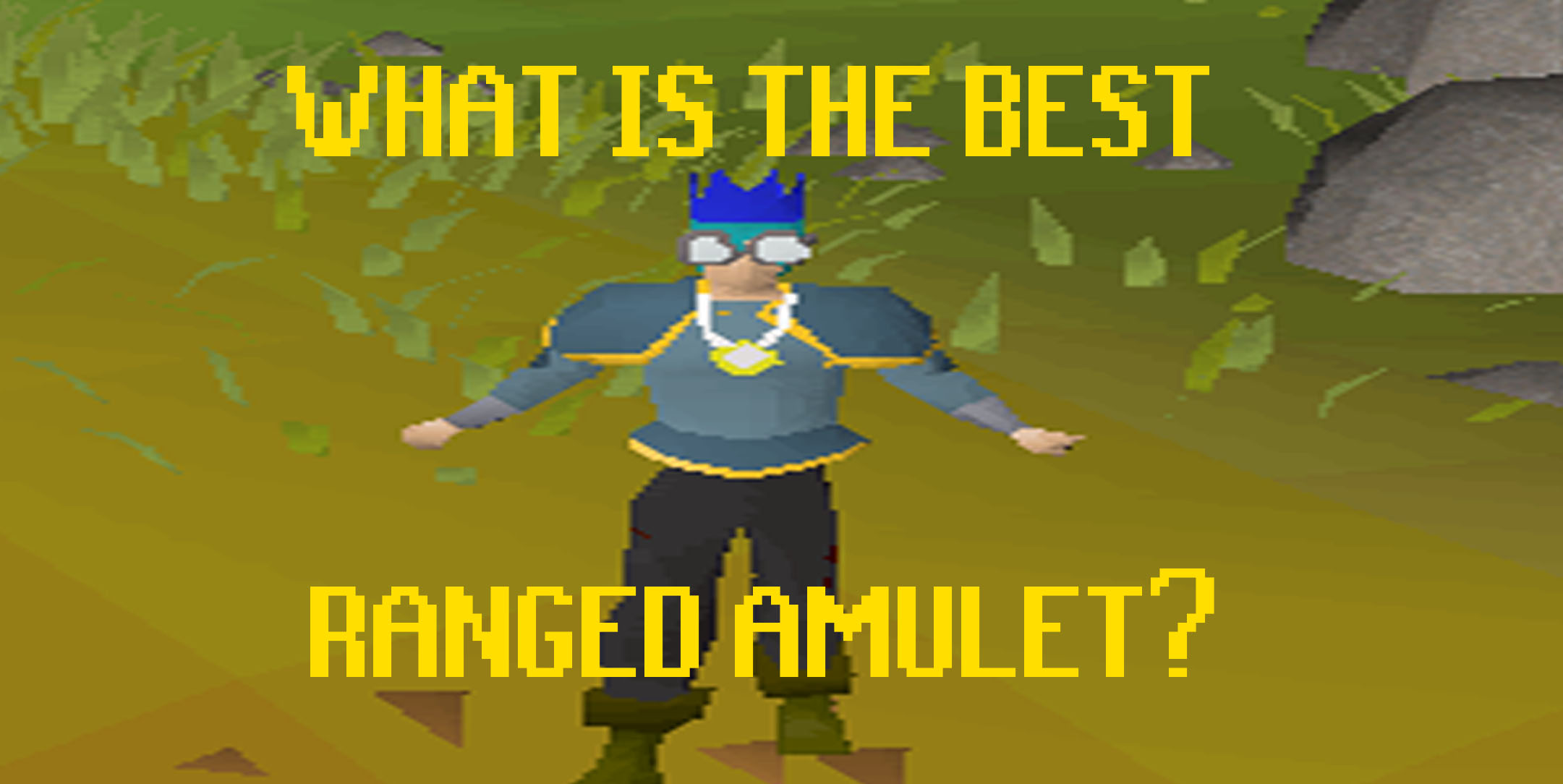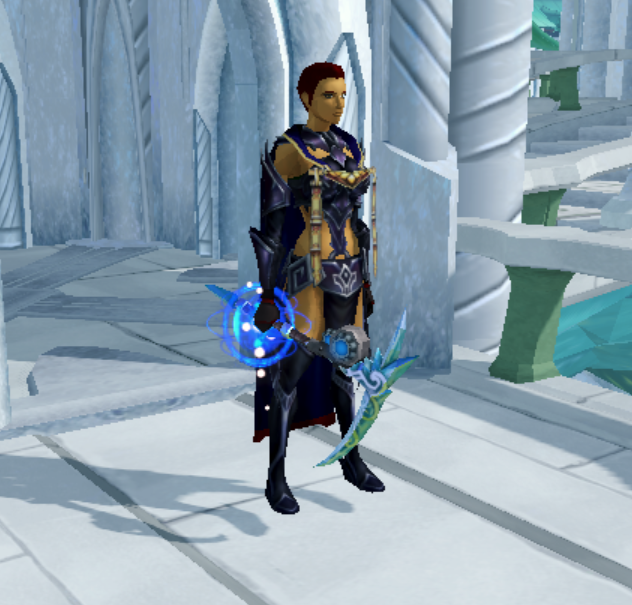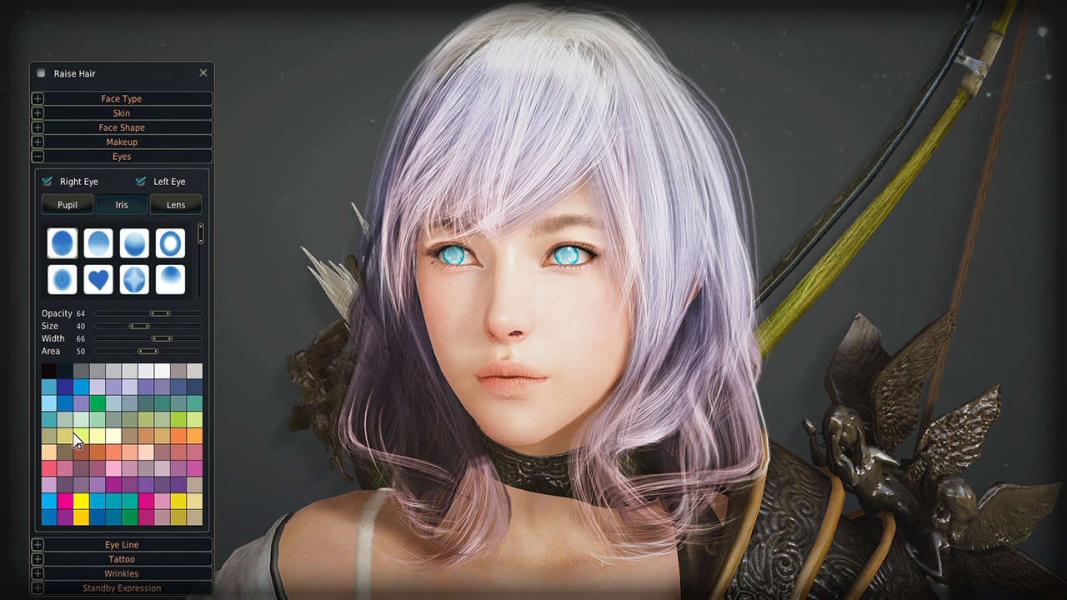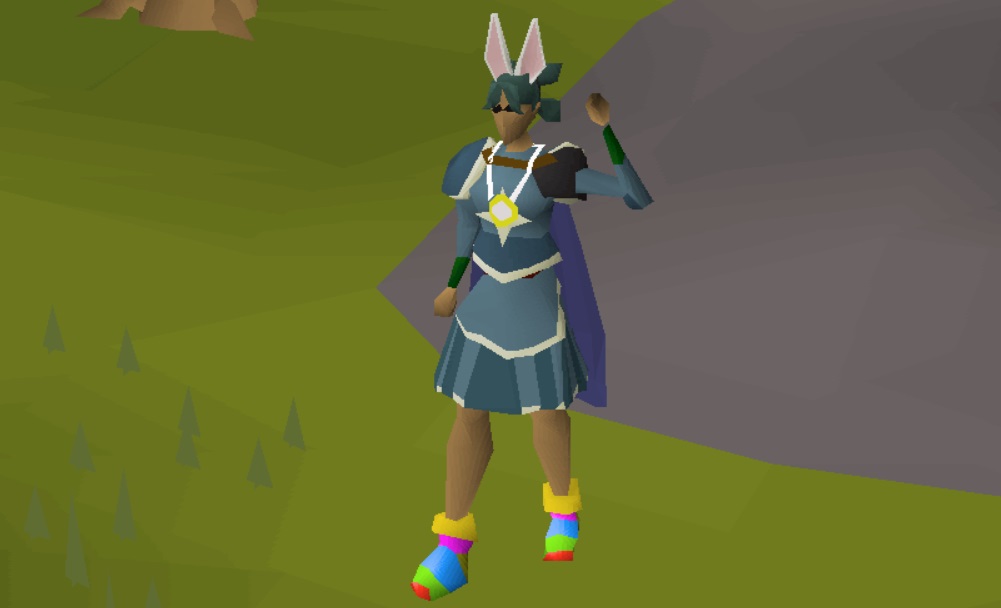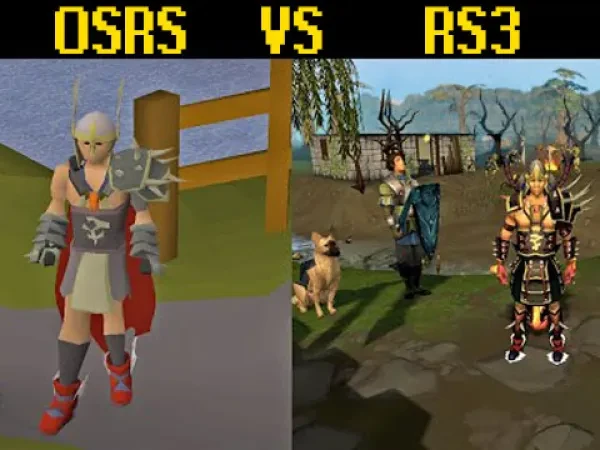
Introduction
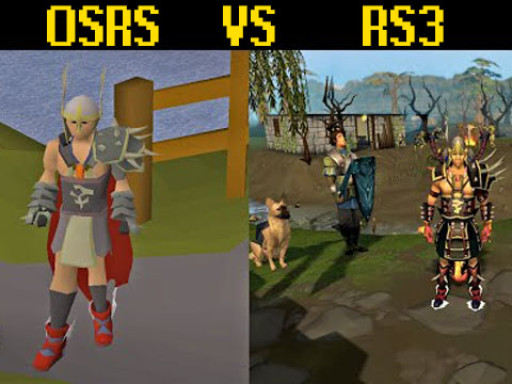
RuneScape has been around since the 4th of January 2001, and in its 20-year history, the game has had several eras of development. The results from this saw the emergence of several different ‘spin-offs’ from the original game.
Two versions of the game exist RuneScape (also known as RS3) and Old School RuneScape (also known as OSRS). Today we will be discussing these two versions of the game to explain the top 10 differences between them.
RS3 is the third era of RuneScape. Arguably this began with the introduction of the Evolution of Combat, WOW-style abilities were adopted, and a revamp of equipment and the combat triangle in 2012. Then later, the full-release of an RS3 client on the 22nd July 2013.
Old School RuneScape was born from a nostalgic group of players and long-time game lovers who did not like the new combat system. In addition, Jagex was under pressure with the rise of RS private servers and people demanding a reversal on the major combat update. Luckily, after discovering an old 2007 backup server, the old school game was released to the public in early 2013.
10. Tradable Discontinued Items
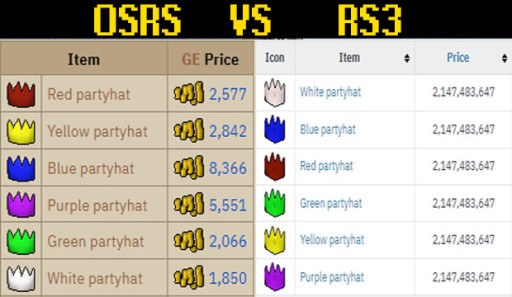
The current prices for party hats listed on the OSRS and RS3 wikis.
One of the most apparent differences between OSRS and RS3 is the implementation of rare items. In RS3, Jagex never intended for rare items to exist in a way that would be worth billions of GP two decades after they were dropped in a seasonal event.
If you want any set of party hats dropped during the 2001 Christmas event, you can try and buy them in the GE each at a max cash stack (2,147m). With six party hats to choose from (white, blue, red, green, yellow, and purple) that will set you back close to thirteen Billion GP, but what if I told you they go for much more than that on the forums?
The point is that these items constantly fluctuate as the demand for them grows, but their number is finite. This is also the case for all other tradeable rare items released via other seasonal events and canned updates. Learn more about these here: Discontinued rare items | RuneScape Wiki | Fandom.
On the other hand, when OSRS came out in 2013, Jagex wanted to ensure they didn’t have rare items like RS3. So in the seasonal events, you get access to the previous tradeable rewards regardless of what year it is. This ensures a constant resupply of ‘rare items’ such as the Christmas cracker and party hat so that they always stay at a low price. So, for example, to get a complete party hat set, you need only spend between 20-25k. Learn more about this here: Holiday items | Old School RuneScape Wiki | Fandom.
9. Tutorial island

OSRS has this introduction to the game, teaching you the basics of skilling and combat and quests and navigating the interface. It is a simple and effective way of leading new players from task to task before they are teleported to Lumbridge and left on their own to forge their path. Once a player leaves this area, they can never return.
On the other hand, most of the lifespan of RS3 Tutorial Island did not exist. In 2008 the island tutorial was replaced by the quest Learning the Ropes (Learning the Ropes - The RuneScape Wiki), and then a year later was temporarily reinstated. Before yet another tutorial replaced it once again in 2009 (Unstable Foundations).
In 2012 with the release of the evolution of combat, the Ashdale Tutorial came into the game (Ashdale Tutorial). With Tutorial island being removed from the map on the 28th November in that same year.
It wouldn’t be until three years later, on the 14th of December 2015, that they explained why the island vanished during the Beneath Cursed Tides quest. The island was a former school for adventures and had become cursed and sunken under the sea (Beneath Cursed Tides).
It was in late 2018 that RS3 finally saw the return of an old classic tutorial island. This rendition is a modern spin on a classic tutorial iconic to Runescape.
8. Microtransactions

RS3 has been infamous in the Runescape community for microtransactions and various Pay-2-win schemes since the 2nd April 2012. The tale begins with the Squeal of Fortune (SoF), which provided spins on a wheel to players daily for a chance to win prizes, including experience (XP) lamps and coins.
SoF was the first time Jagex has allowed the ability to purchase in-game advantages with real-world money. So naturally, players were angry, and many quit with the effect this wealth advantage people now had over others. Effectively, people could now pay to max their characters.
Three months later, on the 17th of July, Solomon’s General Store (SGS) came into the game. Players had to buy RuneCoins by using real money or winning them through the SOF.
Updates like these continue for RS3 as bonds later came into the game in 2013. Today in 2021, most people can max an account and get the best gear without playing the game. To see an in-depth history of the last decade on this subject. See: Microtransactions | RuneScape Wiki | Fandom.
On the other hand, OSRS has not implemented microtransactions to the same degree as RS3. Yes, they have bonds that allow you to pay money to sell bonds in the GE for gold or pay for membership. However, to level your character, you still need to play the game.
Many in the OSRS community pride themselves on the fact that the game is not a pay-2-win system. Instead, it allows for fun competition on the high scores where regardless of your wealth, you can compete with all the rest.
7. Combat
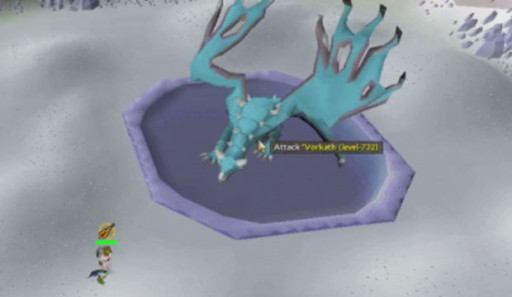
OSRS’ combat compared to RS3 is simplistic but old school. Nevertheless, the style appeals to so many that it doesn’t take much to learn. Furthermore, It can also be complex for those who take the time to push the system’s limits.
The Evolution of Combat (EoC), just before the release of RS3, was a complete reworking of the previous combat system in late 2012. The result was a much more complex system that changed the direction of the game forever.
In OSRS, you have three combat styles: Melee, Ranged, and Magic. These each is affected by certain bonuses based on the equipment you wear and the level of your combat-related skills. For example, Melee is affected by Strength and Attack, while Magic is affected by… well, Magic.
In RS3, the combat styles work similarly, but with extra bonuses that players in OSRS don’t have access to. For example, RS3 has the summoning skill, which allows for familiars to give you combat bonuses.
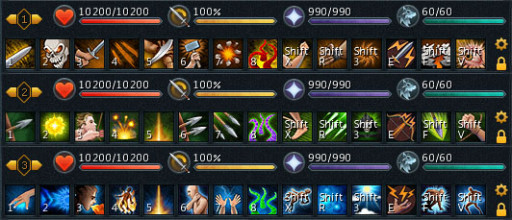
RS3 has an adrenaline bar for both players and creatures to perform abilities in combat. However, this much recharge before some commands can be performed again. Furthermore, it can be disabled if you choose to use the legacy combat style.
In both games, skills themselves have different names—for example, the Constitution of Hitpoints.
Hitpoints of a player in OSRS max out at 99 without any brews. However, executed in RS3, they have increased the hitpoints to 999.
Combat Levels in OSRS max out at 126, but in RS3, they max out at 138 with summoning.
As you can see, there are a lot of differences in combat between the two games. To learn more, check out these links:
6. Faster XP rates and AFK Training
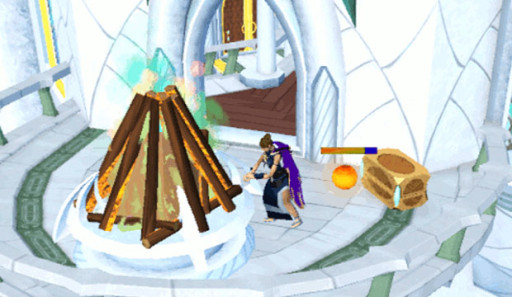
In general, since the release of RS3 XP, rates and skill training has become more AFK. This results from updates to dead skilling content to keep the interest in the game alive and to answer the demand from players who want to train in such away.
XP rates per hour have increased over time due to many factors in RS3. Firstly, better training methods, and players getting better at the game due to guides. However, most of this comes down to buffs obtainable from monster drops, skills, and pay-2-win mechanics.
The lower XP rates in OSRS are due to a player base that does not want their hard work to be undermined by players who complain a skill is too slow or tedious. As a result, Jagex has started implementing quality of life updates to revitalize these soft skills while considering accepted XP rates from players. However, as these updates continue, the XP rates will likely start to become comparable to RS3 in the future -without microtransactions, of course!
The same can be said for AFK skills in OSRS. With more updates since the game’s release in 2013, Jagex has implemented many to make dull-clicking skills into AFK training methods. This is beneficial to the game as it allows casual players to enjoy it still, but furthermore by not taking away from the tedious methods which still provide the best experience overall.
5. Boss Fights
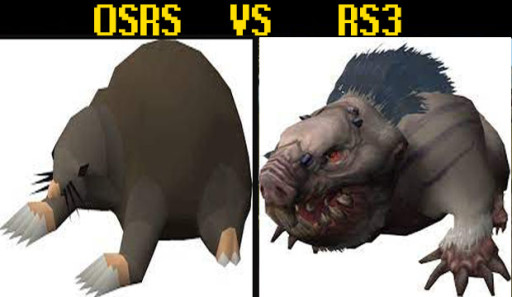
The Giant Mole in both versions of the game.
Bossing in RS3 when using the ability bar is a lot more different than OSRS. Moreover, with better equipment in the game and higher leveled players, the bosses have been updated over time to include more complex battle mechanics. An example is an option of pursuing the classic Giant Mole in a Hard Mode.
Before we go into how this is different from its usual killing method, It is best to explain how this boss works in OSRS. The Giant Mole is a simple boss and is easy to kill when you have a cannon, ranged weapon, stamina potions, and a mole locator from the Falador Hard Diaries.
The Mole can be found in its lair under the Falador Gardens and wanders around in a multi-combat area. However, despite the fact it is level 230, it can be easily fought with protection from melee as it has only one attack style. The hardest thing to deal with is world crashers, loss of Prayer, and the mole digging.
The hard version of the Giant Mole on RS3, however, is much more complex. The mole attacks with melee until she digs, and then she burrows to one of the off-shoot rooms. This is where the fight becomes different from that in OSRS. Each room has a different effect when it buffs the Mole and changes the dynamic of the fight.
4. Voice acting and sound design
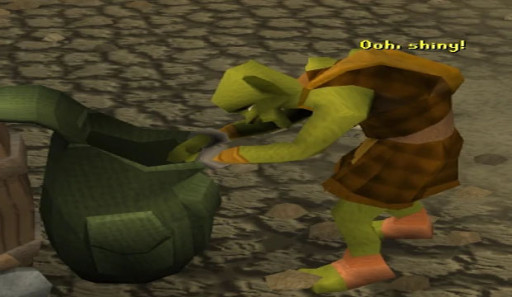
Hear the voice here: https://runescape.fandom.com/wiki/Unstable_Foundations
Several things about sound design in RS3 are an example of how the two games are different. Firstly, the fact that many quests in RS3 are now voice acted. Of course, not all NPCs and quests are voiced, but they add a more modern direction that this client is going in.
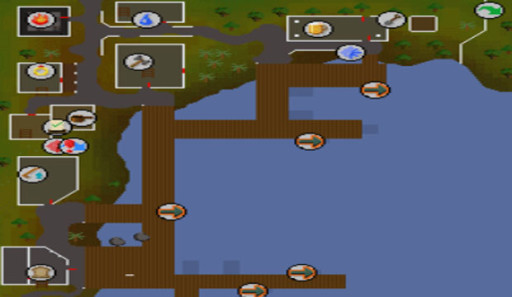
The second example of how the two games are different sound-wise is through the comparison of the most famous RuneScape soundtrack. Sea Shanty 2. OSRS has the classic version of the piece with the jaunty play of accordions to a fun sea-themed melody. Whilst RS3 has a remastered version of the same tune with more string-based instruments taking on a more serious tone as the older version of the game. See Sea Shanty 2 - OSRS Wiki (RuneScape.wiki) and Sea Shanty II - The RuneScape Wiki.
3. Quests
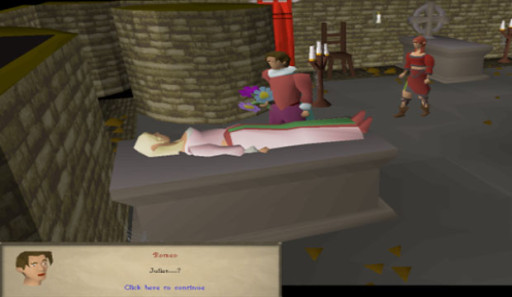
Quests! Yes, this is something that makes the two versions of the game very different from each other. And we would be spending all day listing them all, so I am just going to focus on two free-to-play quests which were changed between 2007 and 2021 RS3.
In OSRS, Varrock has a popular quest called Romeo & Juliet (you might recognize it from a famous play of the same name), and yes, if you have not done this quest, it is exactly like the play my Shakespear with a Runescape flair. See Romeo & Juliet - OSRS Wiki (RuneScape.wiki).
The quest begins with Romeo looking for someone to talk to Juliet. When you do that, she gives a letter to give to Romeo… And so on. There’s a plan to get them to run away together so they can be together, forever!
You speak to a priest, create a fake poison potion, convince Juliet to take it to pretend she is dead. Finally, in the crypt, you drag Romeo to rescue her, but when he arrives, he forgets all about his love for Juliet as he falls for her cousin Philipa. THE END! And it is such a short quest that you get five quest points!
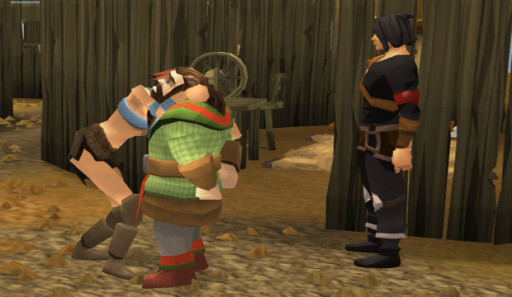
It is probably a good thing that RS3 replaced it with Gunnar’s Ground in 2010. See the details here Gunnar's Ground - The RuneScape Wiki. This quest is an original spin of the same play, but it is about a dwarf poet that falls in love with the Barbarian chieftain’s daughter.
The quest is set in Barbarian Village and is started by speaking to Dororan. He will tell you of his love for Gudrun and wishes to give her a golden ring present. You, as the player, need to see Jeffery get this ring with a love poem and take it to Gudrun.
The player must get her to fall for Dororan but not tell her he is a dwarf as her father hates outsiders. Eventually, Dororan will write to her and then get her to read it to her father, which the player and dwarf listen to in secret.
The quest ends with Gunthor accepting the war over, and anyone can settle in the village. Gundran and Dororan finally meet, and the quest is finished.
Most prefer the RS3 quest. Don’t you?
2. Art Styes
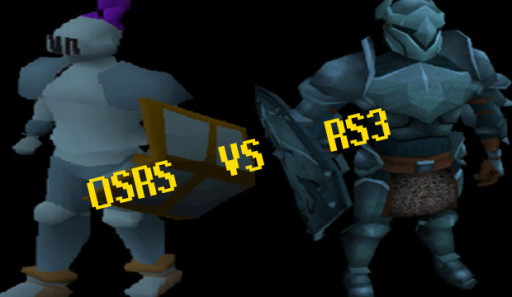
One of the biggest differences between RS3 and OSRS is that their two art styles are so different.
OSRS reflects the older polygon java graphics, which appeals to the nostalgic more senior players of Runescape’s original 2005-2007 era. The game prides itself on this simplistic design and a call-back to early 2000s games of old. The team has pushed the limits of this old style in recent years as they continue to add updates to the game. See more information about this here: Graphical updates - OSRS Wiki (Runescape. wiki).
On the other hand, RS3 has updated HD graphics which have been in the older version of the game since 2008. This update brought High Detail and RuneTek 5 to the game, which drastically defined the period of Runescape from 2008-2012.
With the introduction of RS3 in 2013, the animation abilities have become more complex. RS3, for example, has a further view distance than OSRS, more detail inspires, and animated sprites on more things.
With the EoC, gear was also upgraded in their designs to be more detailed and look vastly different than their OSRS counterparts. Just take rune armor or god swords as an example. You can see more information about this here: Graphics - The RuneScape Wiki.
1. Continent expansions
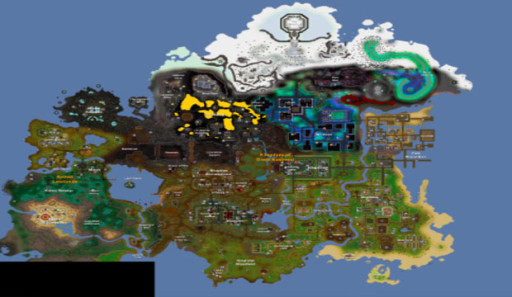
And finally, our number one spot goes to… Continent expansions! Like with quests, I could go on all day about the other updates that make the map of OSRS and RS3 different. But I will briefly focus on two to show you how the two timelines for Runescape have split.
OSRS, on the 7th of January 2016, released the Great Kourend kingdom in the continent of Zeah. It has its lore, quests, bosses, raids, mini-games, and more! It is truly impressive how expansive it is and is still being updated with content.
To make this comparison short, I would say I like the bossing content added to this region, such as with Wintertodt and Raids. They make Firemaking a more exciting skill with rewards, and raids added extra high-level content the game desperately needed. See Great Kourend - OSRS Wiki (Runescape. wiki).
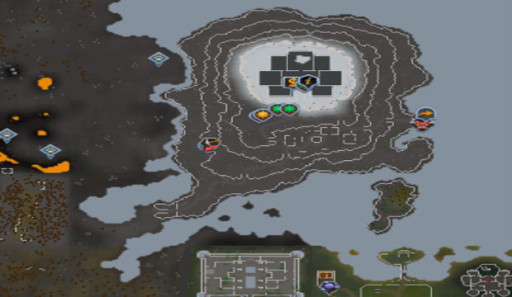
RS3 has a Freminik Stronghold just branching east from the wilderness, called Daemonheim, where the skill Dungeoneerinng can be trained. It came in 2010 with the release of the dungeon-diving skill. See Dungeoneering - The RuneScape Wiki and Daemonheim - The RuneScape Wiki.
This fortress does not exist in OSRS, and only something like raids in Zeah is comparable to this type of content that it offers. In RS3, you work as part of a team going through the dungeons of the fortress looking for treasure to earn points for rewards and leveling up the skill.


